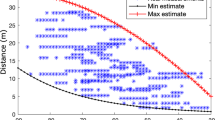Abstract
In this paper, we compare the direct TOA-based UWB technology with the RSSI-based BLE technology using machine learning algorithms for proximity detection during epidemics in terms of complexity of implementation, availability in existing smart phones, and precision of the results. We establish the theoretical limits on the precision and confidence of proximity estimation for both technologies using the Cramer Rao Lower Bound (CRLB) and validate the theoretical foundations using empirical data gathered in diverse practical operating scenarios. We perform our empirical experiments at eight distances in three flat environments and one non-flat environment encompassing both Line of Sight (LOS) and Obstructed-LOS (OLOS) situations. We also analyze the effects of various postures (eight angles) of the person carrying the sensor, and four on-body locations of the sensor. To estimate the range with BLE RSSI, we use 14 features for training the Gradient Boosted Machines (GBM) learning algorithm and we compare the precision of results with those obtained from memoryless UWB TOA ranging algorithm. We show that the memoryless UWB TOA algorithm achieves 93.60% confidence, slightly outperforming the 92.85% confidence of the BLE RSSI with more complex GBM machine learning (ML) algorithm and the need for substantial training. The training process for the RSSI-based BLE social distance measurements involved 3000 measurements to create a training dataset for each scenario and post-processing of data to extract 14 features of RSSI, and the ML classification algorithm consumed 200 s of computational time. The memoryless UWB ranging algorithm achieves more robust results without any need for training in less than 0.5 s of computation time.
Graphical Abstract





Similar content being viewed by others
References
A. Ghose, C. Bhaumik, and T. Chakravarty, Blueeye: A system for proximity detection using bluetooth on mobile phones. In: Proceedings of the 2013 ACM Conference on Pervasive and Ubiquitous Computing Adjunct Publication, pp. 1135–1142, 2013.
S. Liu, Y. Jiang, and A. Striegel, Face-to-face proximity estimationusing bluetooth on smartphones, IEEE Transactions on Mobile Computing, Vol. 13, No. 4, pp. 811–823, 2013.
S. Shankar, R. Kanaparti, A. Chopra, R. Sukumaran, P. Patwa, M. Kang, A. Singh, K. P. McPherson, and R. Raskar, Proximity sensing: Modeling and understanding noisy rssi-ble signals and other mobile sensor data for digital contact tracing. arXiv preprint arXiv:2009.04991, 2020.
Z. Su, K. Pahlavan, and E. Agu, Performance evaluation of covid-19 proximity detection using bluetooth le signal, IEEE Access, Vol. 9, pp. 38891–38906, 2021.
O. Semenov, E. Agu, K. Pahlavan, and Z. Su, Covid-19 social distance proximity estimation using machine learning analyses of smartphone sensor data, IEEE Sensors Journal. https://doi.org/10.1109/JSEN.2022.3162605, 2022.
S. Gezici, and H. V. Poor, Position estimation via ultra-wide-band signals, Proceedings of the IEEE, Vol. 97, No. 2, pp. 386–403, 2009.
A. Hatami, and K. Pahlavan, Performance comparison of rss and toa indoor geolocation based on uwb measurement of channel characteristics. In: 2006 IEEE 17th International Symposium on Personal, Indoor and Mobile Radio Communications, pp. 1–6, 2006. IEEE.
DW1000, 3.5 - 6.5 GHz Ultra-Wideband (UWB) Transceiver IC with 1 Antenna Port, 2022. https://www.decawave.com/product/dw1000-radio-ic/.
S. Dwivedi, R. Shreevastav, F. Munier, J. Nygren, I. Siomina, Y. Lyazidi, D. Shrestha, G. Lindmark, P. Ernström, and E. Stare, et al., Positioning in 5g networks, IEEE Communications Magazine, Vol. 59, No. 11, pp. 38–44, 2021.
A. Dammann, R. Raulefs, and S. Zhang, On prospects of positioning in 5g. In: 2015 IEEE International Conference on Communication Workshop (ICCW), pp. 1207–1213, 2015. IEEE.
R. Keating, M. Säily, J. Hulkkonen, and J. Karjalainen, Overview of positioning in 5g new radio. In: 2019 16th International Symposium on Wireless Communication Systems (ISWCS), pp. 320–324, 2019. IEEE.
F. Wen, J. Kulmer, K. Witrisal, and H. Wymeersch, 5g positioning and mapping with diffuse multipath, IEEE Transactions on Wireless Communications, Vol. 20, No. 2, pp. 1164–1174, 2020.
Structured Contact Tracing Protocol, Boston, MA, 2020. https://mitll.github.io/PACT/.
K. Pahlavan, Indoor Geolocation Science and Technology, pp. 104–109. River Publishers, Denmark, 2019.
K. Pahlavan, J. Ying, Z. Li, E. Solovey, J. P. Loftus, and Z. Dong, Rf cloud for cyberspace intelligence, IEEE Access, Vol. 8, pp. 89976–89987, 2020.
Acknowledgements
The authors would like to acknowledge contributions of Dr. Nader Moayeri of the National Institute of Standard and Technology for fruitful discussions on development of thoughts resulting in this research and his productive comments on the reference [4] that laid the foundation of this study. This work was supported in part by the Defense Advanced Research Projects Agency (DARPA) Warfighter Analytics using Smartphones for Health (WASH) Program under Agreement FA8750-18-2-0077.
Author information
Authors and Affiliations
Corresponding author
Additional information
Publisher's Note
Springer Nature remains neutral with regard to jurisdictional claims in published maps and institutional affiliations.
Rights and permissions
Springer Nature or its licensor holds exclusive rights to this article under a publishing agreement with the author(s) or other rightsholder(s); author self-archiving of the accepted manuscript version of this article is solely governed by the terms of such publishing agreement and applicable law.
About this article
Cite this article
Su, Z., Pahlavan, K., Agu, E. et al. Proximity Detection During Epidemics: Direct UWB TOA Versus Machine Learning Based RSSI. Int J Wireless Inf Networks 29, 480–490 (2022). https://doi.org/10.1007/s10776-022-00577-4
Accepted:
Published:
Issue Date:
DOI: https://doi.org/10.1007/s10776-022-00577-4




